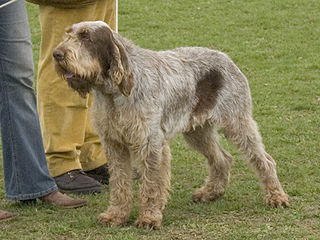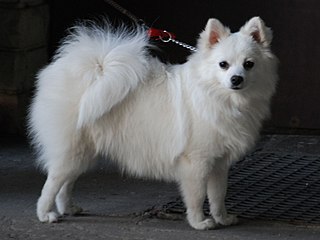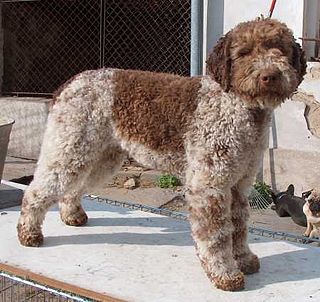Related Research Articles

The Italian Greyhound is an Italian breed of small sighthound. It may also be called the Italian Sighthound.

A hound is a type of hunting dog used by hunters to track or chase prey.

Scent hounds are a type of hound that primarily hunts by scent rather than sight. These breeds are hunting dogs and are generally regarded as having some of the most sensitive noses among dogs. Scent hounds specialize in following scent or smells. Most of them tend to have long, drooping ears and large nasal cavities to enhance smell sensitivity. They need to have relatively high endurance to be able to keep track of scent over long distances and rough terrain. It is believed that they were first bred by the Celts by crossbreeding mastiff-type dogs with sighthounds. The first established scent hounds were St. Hubert Hounds bred by monks in Belgium during the Middle Ages.

The Bergamasco Shepherd, Italian: Cane da Pastore Bergamasco, is an Italian breed of sheepdog. It originated in the Alpi e Prealpi Bergamasche, where it was used as a herding dog for both sheep and cattle.

The Spinone Italiano is an Italian breed of hunting dog, traditionally used for tracking, for pointing and for retrieving game.

The Cane Corso is an Italian breed of mastiff. It is usually kept as a companion dog or guard dog; it may also be used to protect livestock. In the past it was used for hunting large game, and also to herd cattle.

The Volpino Italiano or Volpino is an Italian breed of dog of Spitz type. It is closely related to the Pomeranian and to the German Spitz.

The Maremmano-Abruzzese Sheepdog, Italian: Cane da pastore Maremmano-Abruzzese, also called Maremmano, Maremma Sheepdog, or Abruzzese Sheepdog, is an Italian breed of livestock guardian dog. It is indigenous to Central Italy, especially to the Maremma region of Tuscany and Lazio, and to some northern areas of Southern Italy, particularly to Abruzzo. It has been used for centuries by Italian shepherds to guard sheep from wolves. The "Maremmano" name derives from that of the Maremma marshlands where, until recently, shepherds, dogs and hundreds of thousands of sheep over-wintered, and where the dogs are still abundant although sheep-farming has decreased substantially. However, the breed is still widely employed in and closely culturally associated with the nearby region of Abruzzo, where sheep herding remains vital to the rural economy and the wolf remains an active and protected predator.

The Lagotto Romagnolo is an Italian breed of dog. It originates in the marshlands of the Delta del Po in the eastern part of the Romagna sub-region of Italy. The name derives probably from the term “lagotto” which is the name of the inhabitants of the local town of Lagosanto. Another theory believes it comes instead from Romagnol can lagòt, meaning "water dog". Its traditional function was as a gun dog, specifically a water retriever; since the drainage of large areas of wetland habitat in its area of origin, it is now more often used to hunt for truffles.

The Cirneco dell'Etna is an Italian breed of hunting dog from the Mediterranean island of Sicily. It is named for the Etna volcano in eastern Sicily. It has a keen sense of smell, and is used to hunt small game, particularly rabbits. As with many working dogs, registration is conditional on successful completion of a working trial.

The Bracco Italiano is an Italian breed of pointing dog.

The Segugio Italiano is either of two Italian breeds of dog of scent hound type, the wire-haired Segugio Italiano a Pelo Forte or the short-haired Segugio Italiano a Pelo Raso. Apart from the coat type, they are closely similar, and in some sources may be treated as a single breed; the Fédération Cynologique Internationale and the Ente Nazionale della Cinofilia Italiana treat them as separate. They are also genetically close to the other two Italian scent hound breeds, the Segugio Maremmano and the Segugio dell'Appennino. They are traditionally used for hunting hare, but may also be used in boar hunts.

The Neapolitan Mastiff or Mastino Napoletano is an Italian breed of large dog of mastiff type. It descends from the traditional guard dogs of central Italy. It was recognised as a breed by the Ente Nazionale della Cinofilia Italiana in 1949, and accepted by the Fédération Cynologique Internationale in 1956.

The Rastreador Brasileiro is a large breed of dog from Brazil, first recognised by the Fédération Cynologique Internationale in 1967, but an outbreak of disease, compounded by an overdose of insecticide, wiped out the breed's entire breeding stock. The FCI and the Brazilian Kennel Club then declared the breed extinct in 1973 and delisted it. Since then, efforts have been made to re-create the breed. The Rastreador Brasileiro is a hunting dog of the scenthound type. The breed is also known by the names Urrador or Urrador Americano, in reference to the American (U.S.) coonhounds in its background. In 2013, the Brazilian Kennel Club (CBKC) officially re-recognized the breed. The FCI Breed Standard was produced in 2019.

The Lupo Italiano is a dog breed from Italy. According to its creator, the breed's foundation was a wolf hybrid produced from crossing a German Shepherd and an Italian wolf, though a number of genetic studies put this in doubt.

The Italian Landrace is an Italian breed of domestic pig. It derives from the Danish Landrace breed developed in Denmark at the end of the nineteenth century. Stock was imported into Italy after the Second World War. The breed has been selected principally for suitability for the production of prosciutto crudo. It is, after the Large White Italiana, the second-most numerous pig breed in Italy. The breed standard is issued by the Ministero delle Politiche Agricole Alimentari e Forestali, the Italian ministry of agriculture and forestry; the herdbook is kept by the Associazione Nazionale Allevatori Suini, the national pig-breeders' association.

The Segugio Maremmano is an Italian breed of scent hound from the coastal plains of the Maremma, in Tuscany. It is mainly used for hunting wild boar, but may also be used to hunt hare and other mammals. They may be either smooth-haired or rough-haired.

The Ente Nazionale della Cinofilia Italiana, usually known as the ENCI, is the national organisation responsible for the recognition, standardisation and registration of pedigree dogs in Italy. It is sometimes called the Italian Kennel Club.

The Cavallo Romano della Maremma Laziale, or "Roman horse of the part of the Maremma that is in Lazio", is a horse breed native to the Lazio region of Italy. An ancient breed, it was officially recognised only in 2010; it is now one of the fifteen indigenous horse "breeds of limited distribution" listed by the AIA, the Italian breeders' association. The Lazio region has assigned it the conservation status "at risk of erosion". The population numbers about 800, of which most are in the comune of Monte Romano in the province of Viterbo; a herd of approximately 200 is at Ponzano Romano in the province of Rome, and others are in the province of Rieti.
References
- 1 2 3 Standard del Segugio dell'Appennino (in Italian). Ente Nazionale della Cinofilia Italiana. Accessed July 2020.
- 1 2 3 Segugio dell'Appennino (in Italian). Ente Nazionale della Cinofilia Italiana. Accessed July 2020.
- ↑ Razze Italiane (in Italian). Ente Nazionale della Cinofilia Italiana. Accessed February 2021.
- 1 2 Fabrizio Crivellari (9 March 2010). Segugio dell'Appennino (in Italian). Ente Nazionale della Cinofilia Italiana. Accessed July 2020.
- 1 2 Vincenzo La Manna, Emiliano Lasagna, Simone Ceccobelli, Piera Di Lorenzo, Attilio M. De Cosmo, George Attard, Francesca M. Sarti, Francesco Panella, Carlo Renieri (2015). Genetic Differentiation Between Segugio Dell'Appennino and Segugio Maremmano Dog Breeds Assessed by Microsatellite Markers. Italian Journal of Animal Science. 14 (3): 327–331. doi:10.4081/ijas.2015.3809.